Parque Natural de Urkiola · Ayuntamiento de Abadiño
Situación
Menú principal
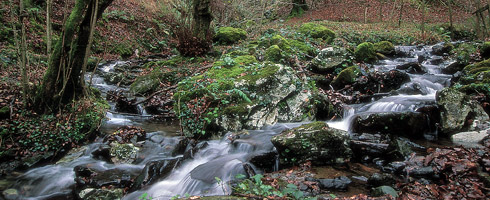
The wetlands or areas by water in the Park are limited to small streams, springs, watering holes and meadows that are temporarily under water. This type of habitat has a community of very specific vertebrates, which small in terms of the number of species, but very important from the conservation point of view, as some of them are rare and endangered species.
Out of the four fish to be found in the park, both the common trout and the minnow are to be found in practically all the streams. The chub and, possibly the odd rainbow trout, were introduced for fishing purposes years ago.
The wetlands, particularly the ponds, watering holes and the pools along the streams, are essential for amphibians to breed and their young to survive their initial phases. All the Park’s amphibians can therefore be observed in this habitat at some time in their life cycle. The common frog and the Iberian frog spend all their time in the water and the others, such as the Alpine newt, Palmate newt, salamander, Alpine chough and common toad, are to found there during their breeding season. The Ringe grassnake and the viperine snake are some of the reptiles that live in this habitat. The birds are represented by the grey wagtail and the dipper, and the mammals by the water rat, water shrew and the southern water shrew. Special mention should be made of the unconfirmed possible sightings of the endangered European mink.
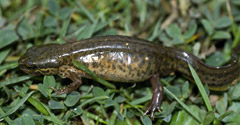
Small newt, 80-85 mm in length and yellowish-brown, olive or brown in colour, with or without dark patches. The belly is light yellow, slightly pinkish towards the ribs. During the breeding season, the male has a low and soft ridge down its back and a higher one on its neck. When the females are on heat, the male also develops spurs on the back legs. It mainly feeds off insects, particularly larva.
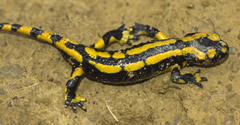
Bright yellow and black amphibian that is up to 20 cm in length. Its patterning is very variable. It moves very slowly and the colour warns us of the unpleasant skin secretion. They mate on land in autumn although the female keeps the eggs in her body until Spring when she goes to the water and lays the larva. It spends most of the time out of the water, particularly in very damp beech copses and feeds off beetles, ants, worms and other invertebrates.
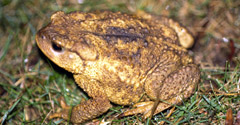
Robust toad that grows up to 15 cm long and is covered in warts. It is usually brown in colour, often with yellow patches. The female is bigger than the male. It is a nocturnal animal and walks instead of hopping over the ground. It spends the majority of its time on land, but it needs large areas of water during its breeding season. The female lays long rows of eggs. It secretes an burning substance through its body gland to fend off predators. It mainly feeds off insects, hagfish and even other amphibians.
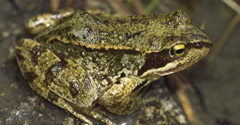
A robust frog that can grow up to 9 cm in length. It can be orangey, reddish, yellowish, brown or greyish in colour. It can have numerous dark spots on its back and legs. A very dark spot always appears behind its eye. It spends a great deal of its time on land, but always in very humid zones. During the breeding season, the female lays huge amounts of eggs in the water. It mainly feeds on insects, aracnids, hagfish, snails and other invertebrates.
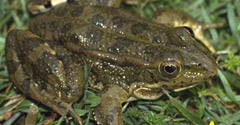
Green frog up to 10 cm, with eyes that stick out. Its pigment can range between green olive, brown or grey and there are normally uneven dark patches that form a type of bank on its legs. This frog lives mainly in the water and it is a diurnal and nocturnal creature. They breed in spring and the female can lay several thousands of small eggs. It mainly feeds off insects, spiders, worms and molluscs.
2006 - 2007 © Anteiglesia de Abadiño Town Council - All rights reserved